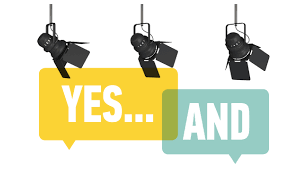By Hanna Bogen

(This will be the first in a two part series of posts on “Improv”)
Improvisation (improv) is often mistaken for stand-up comedy, though the two are fundamentally different. Stand-up comedy typically involves pre-written jokes, memorization, and a polished performance. In other words, it’s the “performance” we wish we could give every time we engage in a social situation. With some realistic reflection, though, one realizes that social situations are intrinsically unpredictable. Scripting is a wonderful way to prepare for the social world, and practice with fundamental concepts of social communication can boost confidence, awareness, and overall success. That being said, there is also great benefit to strengthening our students’ abilities to demonstrate flexibility during social encounters. The fundamentals of improvisation speak directly to building that flexibility, as well as countless other core social communication and social-regulation skills:
- Principle One: Be prepared
- Principle Two: Willingness (to fail spectacularly)
- Principle Three: Stay in the moment
- Principle Four: Quiet down and listen
- Principle Five: Action beats inaction
- Principle Six: Be honest
- Principle Seven: Let go of your need to control
- Principle Eight: There are no mistakes
- Principle Nine: Trust
- Principle Ten: Teamwork
In addition to these ten principles, there is an ultimate, overarching principle of improv that runs, like a golden thread, through each of the other principles: “Yes, and…” The “Yes, and…” principle implies that each social experience is an offer for engagement and successful interaction. It acknowledges that all individuals bring a unique and valuable perspective to the interaction. Practice with improvisational games and activities can strengthen our students’ cognitive flexibility, perspective taking, creativity and shared interest, thereby readying them for greater success in their future social interactions.
One improv game to get you started at home is called “The Imaginary Object.” While best played in a group, this game can be played with as few as two people. One person begins the game by pretending to use an imaginary object; they engage in actions that would be typical of using the object. After a moment of demonstrating the imaginary object, they “pass” the object to the next person, who must continue on with using it. This “passing” continues until all participants have modeled use of the object. At the end, everyone can announce what object they thought they were “holding” or “using.” This game hones awareness and use of nonverbal communication cues including gestures, facial expressions, and body positioning. Participants can talk about which nonverbal cues were helpful in identifying the imaginary object during the game, and/or which cues they would add next time to make understanding of the object more clear.

